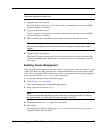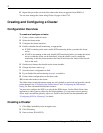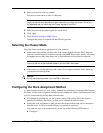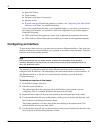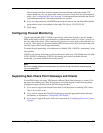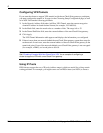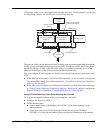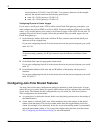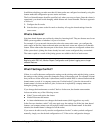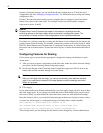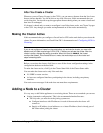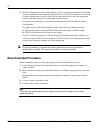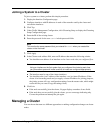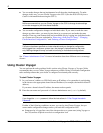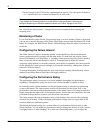
Nokia Network Voyager for IPSO 4.0 Reference Guide 227
In addition to helping you make sure that all cluster nodes are configured consistently, using this
feature makes the configuration process easier and faster.
The list of shared features should be specified only when you set up a cluster. Once the cluster is
operational, you should avoid changing which features are cluster sharable. The basic approach
to follow is:
1. Configure the first node.
2. Join the other systems to the first node so that they all copy the shared settings from the
same source.
What is Sharable?
Join-time shared features are not directly related to clustering itself. They are features used on an
IPSO system regardless of whether it is part of a cluster.
For example, if you want each cluster node to have the same static routes, you configure the
static routes on the first cluster node and make sure that static routes are selected as a sharable
feature. When other nodes become part of the cluster, those routes are configured on them also.
If the system that is joining the cluster already has static routes configured, they are retained.
The routes copied as a result of the joining process are added to the list of static routes.
Note
Beginning with IPSO 4.0, Monitor Report Configuration and System Logging are no longer
sharable features.
What if Settings Conflict?
If there is a conflict between configuration settings on the existing node and the joining system,
the settings on the joining system are changed to those of the master node. For example, assume
that you have a cluster with nodes A (the master) and B in which DNS is a shared feature and the
domain name on node A is company-name.com. If a third node (C) joins the cluster and its
domain name is foobar.com before it joins, foobar.com is replaced by company-name.com
during the joining process.
If you change the domain name on node C back to foobar.com, the domain name remains
foobar.com unless any of the following occurs:
Node C leaves and rejoins the cluster.
Nnode B becomes the master.
A cluster administrator user changes the domain name (while logged into any node).
In the first two situations, node C will once again copy the settings for all the join-time shared
features, and company-name.com will replace foobar.com as the domain name. In the third
situation, the domain name is changed on all the nodes.
If you want to be able to easily reset the configuration of node C to what you had configured
manually, simply save the desired configuration on C. If the active configuration changes



